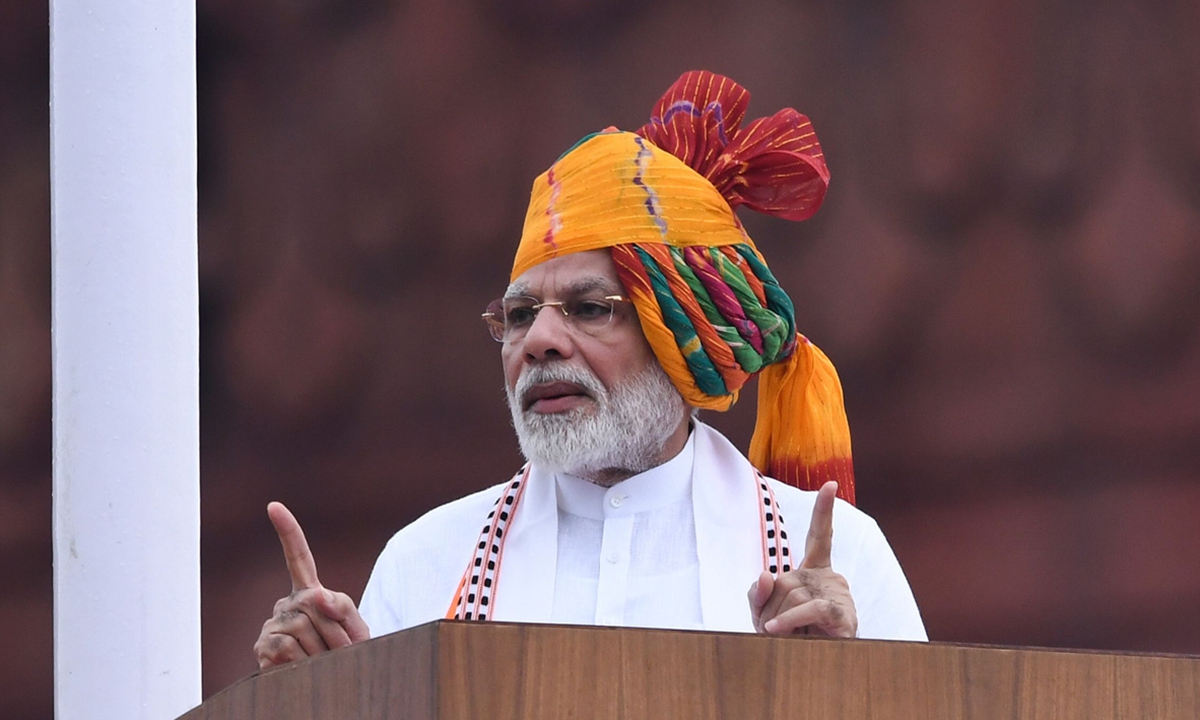
Indian Prime Minister Narendra Modi File photo:VCG
Indian Prime Minister Narendra Modi is
poised to embark on his third term, riding the wave of a resounding victory for the Bharatiya Janata Party.
Reuters reported that Modi plans post-election reforms to rival Chinese manufacturing. However, the challenges for this Indian leader are far from trivial. From ambitious global manufacturing goals to various domestic issues, Modi's path will be anything but smooth.
During his first two terms, Modi built substantial political capital. However, the question remains: Will this capital be enough to achieve his objectives and back the more challenging and substantive reforms required in his third term?
Strong rhetoric and decisive policies might boost short-term political support, however, India's long-term rise as the "world's factory" hinges on cultural shifts and increased social inclusivity.
According to Reuters, the Modi government's future focus will be on boosting India's share in global manufacturing to 10 percent by 2047. The data, though, is striking.
Statistics show that manufacturing's share of India's GDP dropped from 15.16 percent in 2016 to 13.98 percent in 2021. In contrast, China's manufacturing sector's share has remained stable at over 26 percent during the same period.
India has a long way to go before it replaces China as the global manufacturing hub.
The primary challenge for India remains the quality of its workforce. This issue is not only about education levels but also cultural constraints.
The caste system limits education and career opportunities for lower caste groups, which directly impacts the overall labor productivity of the nation.
Only 32.7 percent of Indian women participate in the labor market, significantly lower than China's 60.5 percent. This low labor force participation rate among Indian women is directly related to religious beliefs and family values.
Economically, despite Modi's emphasis on replacing China in the global supply chain, Indian manufacturing still relies on Chinese intermediate goods and raw materials.
India depends on Chinese equipment and auxiliary materials, even in its strong textiles sector. The US and the West have restructured global supply chains, benefiting India. Still, the real challenge lies in balancing economic ties with China, which will shape India's future trade and diplomatic policies with its neighbor.
Public opinion indicates that the recently successful Modi government will likely implement a more assertive foreign policy, especially concerning perceived security risks from China, demonstrating a stricter position on border issues. Emphasis may be placed on Hindu nationalism to garner local backing. Nevertheless, this approach could clash with the necessity for enhanced economic and trade collaboration with China, possibly impeding initiatives aimed at economic growth, particularly in manufacturing.
Although the Modi administration understands the importance of the "dragon-elephant dance" emphasized by the Chinese side, achieving this scenario requires extremely high political wisdom and powerful public opinion guidance.
The deep-seated need for cultural change in India is at the core of all these issues. China's initial development during its reform and opening-up phase demonstrated the vital role of workers' cultural attitudes, including their work ethic, values, and views on education and family outlook.
Scholars have noted that post-World War II, only a handful of East Asian countries achieved actual industrialization. These countries, including Vietnam, are all Confucian societies. Only economic policies that align with and fully leverage the cultural attitudes of the local workforce can lead to successful industrialization. This means that even liberal economic policies might fall short in driving industrialization, and the reforms needed to elevate workers' attitudes will be long and arduous.
Cultural attitude reforms are always long-term and challenging endeavors. Even a capable leader such as Modi will need help in swiftly altering the deeply ingrained traditional perspectives in India. However, the more significant concern is that the Modi administration's policy decisions must depend on strengthening the traditional cultural mindset that requires reforms.
Modi's third term is bound to be filled with challenges. He faces the task of boosting economic figures and the daunting challenge of driving a profound cultural transformation in a society deeply bound by tradition.
乌白马角网原创文章,未经授权禁止转载。详情见转载须知。

文章点评: